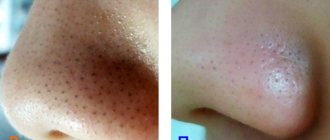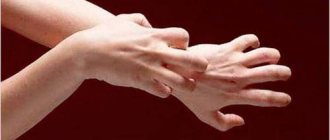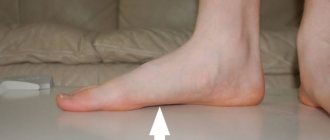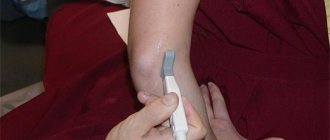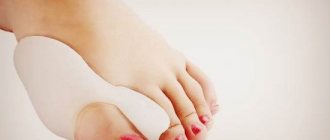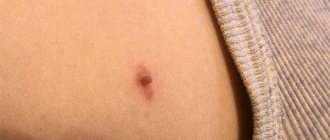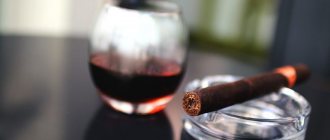Gout is a chronic disease that is accompanied by an increase in the concentration of uric acid in the blood. As a result of its accumulation, urate salts begin to be deposited in the joint area. Subsequently, destruction of the joint tissue and impairment of functional abilities occurs.
Fatty foods, a sedentary lifestyle and alcohol abuse lead to an increase in morbidity among the population. The Yusupov Hospital provides a full course of diagnosis and treatment of gout at any stage of development. Modern equipment, a professional team and high quality services distinguish the clinic from other medical institutions.
According to statistics, men are several times more likely to suffer from gout compared to women. The onset of the disease occurs at 40 years of age. In women, gout is diagnosed closer to 60 years of age. This is explained by a set of certain hormones that help remove excess uric acid from the body. In recent years, doctors have been talking about diseases. Gout can be diagnosed at the age of 20-30 years.
Reasons for the development of the disease
Hyperuricemia is the main cause of gout. This condition occurs in the following cases:
- Obesity. The diet of a gout patient included an excessive amount of fatty foods, simple carbohydrates and high-calorie foods. In addition, eating large amounts of meat increases the risk of developing gout;
- Alcohol abuse;
- History of psoriasis and hypertension;
- Hereditary predisposition.
An increase in the concentration of uric acid occurs as a result of the fact that healthy kidneys are not able to filter its sharply increased amount. Kidney pathology does not allow them to process even normal amounts of uric acid.
Prevention
To prevent cyst formation, you must follow the following rules:
- If there is a hereditary predisposition to hygroma, you need to avoid injuring your hands, protect your joints, and limit monotonous mechanical loads on your hands.
- During physical work, distribute the load evenly between your hands. If you regularly engage in such activities, then use elastic bandages.
- Treat tendovaginitis (inflammation of the tendon sheath) and bursitis (inflammation of the mucous bursae of the joints) with a chronic course in a timely manner.
The latter pathologies often cause the appearance of a tumor.
As you can see, finger hygroma is not a dangerous pathology. But in order to avoid unpleasant consequences, you need to seek medical help in time and carry out competent therapy. You should not self-medicate, as this will only worsen your condition.
Classification
Depending on the nature of the course of the disease, primary gout is distinguished - an independent disease that occurs against the background of exposure to provoking factors, and a secondary form of the disease, which develops against the background of concomitant pathology. Based on the prevalence of the pathological process, gout is divided into the following types:
- Monoarticular arthritis. Urates accumulate in the area of one joint. Characteristic of the onset of the disease. The most common site of monoarticular arthritis is the big toe joint;
- Polyarticular arthritis. Inflammation affects more than 2 joints. Polyarticular arthritis is characteristic of chronic gout. Localized in the joints of the elbows, wrists, legs, feet and hands.
Make an appointment
Taylor (tailor) deformation
Taylor deformity is characterized by varus deviation of the fifth toe and valgus deviation of the fifth metatarsal bone.
Characteristic signs of a “bump” on the foot:
- located at the base of the little finger;
- the fifth finger is deflected inwards, in some cases also upwards;
| “Bone” in Taylor deformity in combination with bursitis |
- The “bump” sharply increases in size and becomes painful when bursitis of the mucous bursa of the fifth metatarsophalangeal joint develops.
| “Bumps” and x-ray of the foot with Taylor deformity |
Symptoms in men
At the initial stages of the disease, there are no clinical signs of gout in men. During preventive examinations or examinations for other pathologies, a biochemical blood test detects an increased level of uric acid - hyperuricemia.
The first sign of gout in men that forces you to see a doctor is pain in the joints. Acute gouty arthritis at the initial stage is most often short-term. The attack develops suddenly, mainly at night. The pain syndrome is intense, constant, pronounced. Target joints affected:
- big toe;
- Thumb;
- Knees;
- Elbows;
- Ankle.
The skin over the joint is hyperemic, swollen, and hot to the touch. The joint is limited in movement, since any mobility provokes increased pain. After a few days, the pain goes away, and the patient returns to his usual way of life.
Further progression of the disease leads to a longer exacerbation of gout symptoms in men, and periods of calm are constantly decreasing. Over time, periods of remission are completely absent, and the pain becomes chronic.
In the stage of chronic arthritis, urates are deposited in connective tissue, organs in the form of nodules, which are called tophi. Deposition of urate in the kidneys is the cause of urolithiasis. Sometimes kidney inflammation develops.
Expert opinion
Author:
Elena Yurievna Panasyuk
Rheumatologist, doctor of the highest category, member of the Association of Rheumatologists of Russia
According to WHO data, 5-20% of Russian residents suffer from pathological accumulation of monosodium urate crystals. They are at risk of developing gout. The disease is registered in 0.1% of the population. Similar statistics in Europe and the United States indicate a more deplorable situation.
The number of newly diagnosed cases of gout is growing every year. The main role among the reasons for the early onset of the disease is given to a person’s lifestyle. The prognosis for recovery and quality of life after diagnosis depends on the stage at which the pathology is diagnosed. Severe gout can cause loss of self-care and normal skills. Late access of the population to a doctor is associated with the absence of a specific clinical picture of the disease in the early stages of development.
Doctors at the Yusupov Hospital perform differential diagnostics, which makes it possible to determine the diagnosis. An individual approach to each patient is necessary to select the correct therapy. The doctor’s tasks include relieving symptoms of gout exacerbation and preventing relapses. For this purpose, the Yusupov Hospital prescribes modern drugs that have passed quality and safety control.
Arthrosis of the tarsal joints
Tarsal joints form between the bones of the midfoot. The midfoot constantly endures heavy loads during walking and running and is injured (microtrauma).
In this case, the articular surfaces are damaged, the cartilage becomes thinner, and over time osteophytes (bone growths) appear - arthrosis develops.
Characteristic symptoms:
- these “bones” are hard, often painful, and can increase in size due to inflammation of the soft tissues;
- they appear on the dorsal surface in the area of the instep of the foot;
- Walking in tight shoes can be very painful.
| A. Osteophytes in arthrosis of the metatarsocuneiform joint | A. Lump due to arthrosis of the metatarsocuneiform joint |
Diagnostics
A comprehensive diagnosis of gout includes the following studies:
- Inspection of joints. It is carried out to identify painful areas;
- General and biochemical blood test. They are carried out to identify the inflammatory process in the body. This is evidenced by high concentrations of leukocytes and ESR. Biochemical analysis shows the level of uric acid and creatinine;
- Radiography. Examination of the affected joints determines the development of tophi, as well as the presence of areas with destroyed articular and bone tissue;
- Ultrasound examination of the kidneys. Against the background of severe gout, urate may begin to be deposited in the kidneys. Ultrasound diagnostics allows you to identify pathological foci in organs;
- Examination of synovial fluid. It is necessary to clarify the etiological factor of the resulting inflammation.
Establishing diagnosis
If a patient notices a suspicious tumor on his finger, he should contact a traumatologist, surgeon or orthopedist.
Reference. The specialist will conduct a differential diagnosis to distinguish the hygroma from the leak (capsule with purulent contents), ganglion (nerve ganglion), epithelial cyst, chondroma (cartilaginous tumor), osteoma (bone tumor), aneurysm (protrusion of the artery wall), malignant formations, etc. d.
First, the doctor collects anamnesis, conducts a visual examination, and palpates the neoplasm.
To clarify the diagnosis, the patient is prescribed the following studies:
- Ultrasound helps evaluate the structure of the formation.
- Magnetic resonance imaging and computed tomography are performed if nodular structure is suspected.
- X-ray.
To analyze the contents of the formation, a puncture is performed. During the examination, the pathological formation is punctured, the necessary cellular material is collected, and then it is studied in the laboratory.
To clarify the diagnosis and create an effective treatment regimen, doctors prescribe the following tests:
- Clinical examination of blood and urine.
- Biochemistry of blood.
- X-ray of the lungs.
- Tests to detect sexually transmitted infections, hepatitis, HIV.
- Electrocardiography.
Once the diagnosis is made, treatment is necessary.
Differential diagnosis
Quite often, gout is mistaken for other diseases. This is due to the similarity of the clinical picture of the pathologies. Differential diagnosis is carried out between gout and the following diseases:
- Purulent arthritis. Occurs after an infectious disease. Purulent arthritis is characterized by hyperthermia. The diagnosis will be clarified with the help of additional studies;
- Rheumatoid arthritis. It occurs more often in women than in men. The final causes of the development of pathology are not fully understood. Unlike gout, rheumatoid arthritis does not increase the concentration of uric acid;
- Psoriatic arthritis. Occurs against the background of skin manifestations of psoriasis;
- Pyrophosphate arthropathy. It differs from gout by characteristic changes on x-ray and in the analysis of synovial fluid;
- Osteoarthritis. The disease not only has similar symptoms, but can also occur against the background of gout.
Only a doctor can distinguish diseases and make an accurate diagnosis. Self-medication can lead to aggravation of the condition and the development of undesirable consequences.
How to treat a lump on your thumb that hurts
Unfortunately, this problem is usually caused by chronic diseases and cannot be completely cured. Only hygroma can be removed once and for all. All other types of growths will remain for life - but exacerbations can be avoided if stable remission is achieved.
Rheumatoid arthritis is treated with corticosteroids or non-steroidal anti-inflammatory drugs. These same non-steroidal anti-inflammatory drugs, as well as colchicine, are effective against gout.
For osteoarthritis, chondroprotectors, finger therapeutic exercises and physiotherapy sessions are prescribed: multi-channel electrical stimulation and laser therapy. With multichannel electrical stimulation, muscles are stimulated with short pulses of electricity to relieve tension and improve blood flow. During the laser therapy procedure, a laser beam is applied to the joint growth to relieve inflammation and activate blood flow within the tissues.
Osteoarthritis is also treated with physiotherapy: ultrasound (reduces tissue volume), shock wave therapy (activates blood flow, eliminates swelling and pain by exposure to acoustic impulses), laser therapy.
Surgery may be required if the cartilage and surfaces of the joints are severely damaged in the later stages of arthritis or arthrosis, and the fingers become swollen, stiff and painful. In especially severe cases, endoprosthetics is prescribed, when a worn-out joint is replaced with an artificial one. The operation can be performed in the presence of a malignant tumor. The oncologist prepares an individual therapy program for each patient.
Traditional medicine is powerless when there is a lump and pain on the finger joint. Not a single homeopathic remedy contains components that would dissolve the lump. Therefore, relying on chance in the case of such a disease is extremely undesirable: all hopes for a miracle can ultimately lead to serious consequences.
Treatment
Doctors at the Yusupov Hospital provide complex therapy for gout. It includes the following components:
- Medications;
- Diet food;
- Lifestyle correction.
Drug therapy for gout at the Yusupov Hospital is carried out using the most effective pharmacological drugs that are registered and approved for use in the Russian Federation. They have a minimal range of side effects. Medicines for gout are prescribed for a long term. The dosage is selected according to the levels of uric acid in the blood.
The objectives of drug therapy are:
- Reduced uric acid levels;
- Reducing the severity of pain and inflammatory syndromes.
The choice of drugs is made by the attending physician on an individual basis. The results of the diagnostics performed are taken into account. For gout, the following medications are prescribed:
- Allopurinol. The action of the drug is aimed at reducing the level of uric acid in the blood. In addition, allopurinol destroys existing urate deposits. It is a sought-after drug for the treatment of gout;
- Febuxostat. Dissolves uric acid salts and reduces the risk of their re-formation;
- Probenecid. Most often used during gout remission. This is due to the lack of effect of the drug on the formation of uric acid;
- Pegloticase. Used in cases of ineffectiveness of other medications;
- Colchicine. The drug prevents the accumulation of uric acid in the body. Due to the large number of side effects, colchicine is used exclusively for the purpose of relieving an acute attack of gout;
- Non-steroidal anti-inflammatory drugs. Reduce the severity of inflammation and have an analgesic effect;
- Glucocorticosteroids. Prescribed to relieve an acute attack of gout. Due to immunosuppression, glucocorticosteroids are used in limited quantities and according to strict indications.
Following a certain diet is an important part of the comprehensive treatment of gout. The daily menu may include:
- Vegetarian soups;
- Limited amount of chicken or duck meat;
- Lenten varieties of fish;
- Fermented milk products (kefir, fermented baked milk, yogurt, cottage cheese);
- Cereals;
- Pasta;
- A sufficient amount of fresh vegetables and fruits;
- Nuts;
- Dried fruits;
- Honey;
- Paste;
- Fruit drinks, compotes, juices;
- Weak tea.
Following a diet is necessary not only during an exacerbation of gout, but throughout life. In this way, it is possible to minimize the number of relapses of the disease.
To reduce uric acid levels, the patient is prescribed medication. Dosages of drugs are selected depending on the indicators. In order to dynamically monitor the effectiveness of treatment, it is necessary to regularly determine the level of uric acid in the blood. A decrease in its concentration indicates positive results of therapy. Control studies are recommended to be carried out every 2-4 weeks, and then once every 6 months. The dose of drugs is gradually reduced until maintenance values are reached. It is extremely rare to completely stop taking medications. Most often this is accompanied by an exacerbation of gout.
After the level of uric acid decreases and the clinical manifestations of the disease disappear, the patient can return to normal life. To prevent recurrent exacerbations, doctors recommend maintaining proper nutrition and leading an active lifestyle.
Drug therapy for calluses
Treatment with medications is shown most effectively in the case of the formation of dry growths, as well as in the formation of calluses on a child’s foot.
Callus plasters are used, which have a keratolytic effect.
This method of therapy has a number of advantages:
- when using keratolytics, symptoms of discomfort are reduced
- the patch prevents infection
- accelerates the healing process of the skin
The pharmaceutical industry produces several types of patches.
Let's look at the commonly used ones:
- Salipod. The active ingredient included in this drug is salicylic acid. Under the influence of acid, dying epithelial cells dissolve, and the reproduction of healthy cells is activated. The patch is effective not only against corns, but also against growths with a shallow penetration rod.
- Mozolin. The substances contained in the patch soften rough skin. The soft layers of the growth begin to peel off and healthy tissue remains in place of the callus.
- Space. The product contains silicone. The drug has hypoallergenic properties, helps eliminate pain and stimulates regenerative processes. The patch is recommended for use by people with sensitive skin.
In addition to patches, preparations in the form of gels and ointments based on lactic or salicylic acids can be prescribed.
They effectively remove rough areas of skin.
For corns and dry growths, Bensalitin ointment can be used, acting as an antiseptic;
The disinfecting effect is expressed in Levomekol and Vishnevsky ointment.
Alkaline solutions: sodium hydroxide - promotes the dissolution of dead cells.
Soda baths have a similar effect.
Removing dry callus with a rod
With prolonged irritation of the skin, cell proliferation increases, which provokes thickening of the skin and contributes to the formation of a convex callus with a core.
Therapy for such growths is long-term.
When the convex part of the growth is cut off, it grows again.
Foot baths help remove dry growths on the legs.
The container is filled with hot water and mustard powder or soda is added to it.
After steaming the foot, the stratum corneum of cells can be easily removed.
Then the rod is treated with celandine juice.
This product should be used with great caution so as not to cause a burn to healthy skin.
The area prepared in this way is sealed with a “Salipod” plaster.
This manipulation usually takes a long time and you have to wait several days for the effect.
The problem can be solved much faster with the help of modern techniques for removing skin growths.
You should consult a doctor if some time has passed after the procedure and there is no result.
It is also necessary to urgently go to a specialist if an inflammatory process has developed in the area of the callus (the skin is inflamed and swollen, pus is released).
The doctor will treat the wound to stop the inflammatory reaction and also tell you what to do next.
Perhaps a specialist will prescribe the use of antibiotics.
The doctor will also need to differentiate dropsy caused by skin rubbing from Steven-Johnson syndrome.
The presence of watery blisters is caused by other reasons.
Forecast
The prognosis for life with diagnosed gout is favorable. Most patients with the disease live to old age. The quality of life improves by following measures to prevent relapses of the disease and undergoing regular examinations by a doctor.
You can get tested for gout at the Yusupov Hospital. The clinic is located in Moscow. The hospital’s equipment makes it possible to accurately determine gout at the initial stages of development. After receiving the research results, experienced doctors develop individual treatment tactics. Modern therapy helps to quickly alleviate the patient's condition. The drugs used meet quality and safety standards. To make an appointment with a rheumatologist, call the contact center of the Yusupov Hospital 24 hours a day, any day of the week.
Make an appointment
Rehabilitation period after surgery
On the first day, the patient is recommended to remain in the clinic under the supervision of a surgeon. The patient is fitted with special orthoses - Baruk boots, which, when walking, relieve the load from the forefoot and toes on the heel. These shoes must be worn for at least 6 weeks. In a difficult situation, you can additionally rely on crutches and limit physical activity.
After surgery, for 2 weeks it is recommended:
- bed rest;
- place a pillow or cushion under your feet to stimulate the outflow of excess fluid;
- for severe pain, apply cold compresses for 30 minutes up to 4 times a day.
To reduce pain, the doctor selects medications individually and calculates the dosage for home use. Swelling begins to decrease on the 3rd–5th day after surgery. After 14 days, it is recommended to visit the surgeon again to remove the skin sutures.
After 6 weeks, the patient is sent for a repeat x-ray. With pronounced positive dynamics and the absence of contraindications, walking without corrective orthoses with a load on the toes is allowed.
In some older patients, swelling may persist for a long time, which is associated with decreased tone of the veins of the extremities. In such a situation, lymphotropic therapy and contrast foot baths are prescribed.



